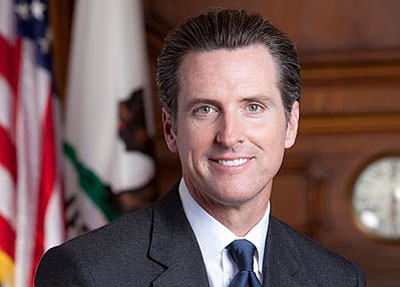COVID-19: State issues new guidance, directives, stats

Calif. Gov. Gavin Newsom
Updated guidance: Seniors and vulnerable residents directed to home isolate
–Following yesterday’s announcement that older adults and those at higher risk for serious illness from COVID-19 should isolate, Governor Gavin Newsom today issued an executive order to protect the health and safety of Californians most vulnerable to COVID-19 residing at health care, residential and non-residential facilities licensed by the state. The order directs state health and social services agencies to redirect resources and staff to the facilities, focusing on providing technical assistance and supporting compliance with core health and safety requirements for caregivers and the cared for.
“These will be challenging times and California is mobilizing every part of government to protect and isolate residents most vulnerable to COVID-19. Those who are over the age of 65, Californians with underlying health issues, residential care patients and all those who care for these individuals are uniquely at risk. In the coming weeks, our state must rally behind these Californians and work aggressively to ensure their needs are safely met.”
The Governor’s order also directs the Health and Human Services Agency to develop alternatives to leverage in home supportive services programs, adult protective services programs, area agencies on aging and regional centers, and other programs to support the home isolation of vulnerable Californians, including seniors and those with serious chronic conditions.
The order directs the following:
- The state must focus on protecting the health and safety of the most vulnerable in licensed facilities.
- The state shall immediately identify health, community care facilities, and other sites that house populations that are most vulnerable to COVID-19. This includes, but is not limited to seniors and individual who require assisted-living services due to chronic health conditions.
- The state shall redirect resources and provide technical and compliance support to protect caregivers and those they care for.
- Enforcement activities shall focus where there are allegations of the most serious violations impacting health and safety.
- The Health and Human Services Agency, in consultation with counties and labor organization and consumers, shall leverage existing services and programs to support home isolation of vulnerable Californians, including seniors and those with serious chronic underlying health conditions.
- To address the increased demand for healthcare workers and first responders, state Departments shall authorize first responders, care providers, and workers who are asymptomatic and taking precautions to prevent the transmission of COVID-19, to continue working during the period of this emergency
The full executive order can be viewed here.
“It is also important that older adults and those at elevated risk of serious illness from COVID-19 take immediate steps to reduce their risk. This includes staying at home as much as possible and practicing social distancing,” said Governor Newsom.
Based on the Governor’s announcement yesterday, older adults, individuals with compromised immune systems, and individuals who have serious chronic medical conditions like heart disease, diabetes, and lung disease should take the following steps:
- Remain at home until order is rescinded, or until further guidance is issued.
- Cancel any non-essential travel, appointments, etc.
- For routine medical care, contact your health care provider to discuss rescheduling.
- Continue with outdoor activities.
- As long as you practice social distancing, we encourage you to continue your outdoor activities such as walks, runs and yardwork, to the extent your health allows it.
- Practice social distancing.
- Maintain distance, at least six feet, between yourself and anyone who is coughing or sneezing.
- Avoid handshaking, hugging or other intimate types of greetings—greet others with a wave, nod or bow instead.
- Stay in touch with others by phone or email.
- Ask friends and family to do any essential grocery shopping, picking up medications, etc.
- You should ask for help from friends, family, neighbors, community health workers, etc. if you become sick.
- Determine who can provide you with care if your caregiver gets sick.
- Family and Caregiver Support
- Family, friends, and caregivers who come to your home to provide you with support should be asymptomatic, meaning having no fever, cough, or other respiratory symptoms.
- Know what medications your loved one or client is taking and see if you can help them have extra on hand.
- Monitor food and other medical supplies (oxygen, incontinence, dialysis, and wound care) needed and create a back-up plan.
- Stock up on non-perishable food items to have on hand in your home.
- Have supplies on hand
- Contact your healthcare provider to ask about obtaining extra necessary medications to have on hand.
- If you cannot get extra medications, consider using mail-order for medications.
- Be sure you have over-the-counter medicines and medical supplies (tissues, etc.) to treat fever and other symptoms.
- Have a plan for if you get sick:
- Consult with your health care provider for more information about monitoring your health for symptoms suggestive of COVID-19.
- Stay in touch with others by phone or email. You may need to ask for help from friends, family, neighbors, community health workers, etc. if you become sick.
- Watch for symptoms and emergency warning signs
- Pay attention to potential COVID-19 symptoms including fever, cough and shortness of breath. If you develop symptoms, call your doctor or local public health department.
- If you develop emergency warning signs for COVID-19, get medical attention immediately. In adults, emergency warning signs* include:
- Difficulty breathing or shortness of breath
- Persistent pain or pressure in the chest
- New confusion or inability to arouse
- Bluish lips or face
- *This list is not all-inclusive. Please consult your medical provider for any other symptom that is severe or concerning.
- Hand washing
- Wash hands frequently for at least 20 seconds.
- Encourage hand washing by family and friends, particularly children.
- Provide alcohol based hand sanitizers to supplement hand washing.
- Avoid touching eyes, nose, or mouth with unwashed hands.
- Clean frequently used devices, such as mobile phones.
- Clean and disinfect your home to remove germs: practice routine cleaning of frequently touched surfaces (for example: tables, doorknobs, light switches, handles, desks, toilets, faucets, sinks & cell phones) with common cleaning supplies
- See the Center for Disease Control and Prevention’s guidance regarding the prevention of disease in homes and residential communities.
- Use “respiratory etiquette.”
- Cover cough with a tissue or sleeve. See CDC’s Cover Your Cough page for multilingual posters and flyers, posted at the bottom of webpage.
- Provide adequate supplies within easy reach, including tissues and no touch trash cans.
The full guidance is available here.
New guidance outlines steps restaurants, bars, wineries, food trucks, grocery stores, and farmers’ markets should take now
Today California officials issued guidance regarding retail food, beverage and other service venues. These venues bring people from multiple communities into close contact with each other and have the potential to increase the transmission of COVID-19.
“These are aggressive, but necessary actions to protect our communities,” said Governor Gavin Newsom. “We all have a role to play when it comes to preventing the spread of COVID-19. These establishments that are remaining open should think creatively about how they can continue to provide services to the community. Shifting operations to focus on pick up and delivery options should be prioritized.”
The guidance will protect individuals attending and working at these venues and prevent the spread of COVID-19 in the community.
Retail Beverage Service Venues:
- Bars, wineries, breweries and pubs should be closed, except for venues that are currently authorized to provide off sale beer and wine to be consumed off premises are allowed.
- This guidance is not intended to affect production of beer and wine.
- Bars, breweries, pubs, and wineries that include meals provided by a full kitchen should follow the restaurant guidance below if they provide delivery or pick-up options
Restaurants/Cafeterias:
- Restaurants should be closed for in-restaurant seated dining and should be open only to drive-through or other pick-up/delivery options.
- Remind employees of best hygiene practices including washing their hands often with soap and water for at least 20 seconds.
- Increase frequency of cleaning and sanitizing per CDC Environmental Cleaning and Disinfection guidance of all hard surfaces, including tables and counter tops that are being utilized by employees and patrons during pickup/delivery options.
Food Trucks:
- Increase frequency of cleaning of menus, cash registers, receipt trays, condiment holders, writing instruments and other non-food contact surfaces frequently touched by patrons and employees.
- Ensure that social distancing of six feet per person for non-family members is maintained and make clear that family members can participate together, stand in line together, etc.
- Limiting the number of people in lines.
- Increase frequency of cleaning and sanitizing per CDC Environmental Cleaning and Disinfection guidance of all hard surfaces.
- Remind employees of best hygiene practices including washing their hands often with soap and water for at least 20 seconds.
Grocery Stores and Charitable Food Distribution Sites
- The food distribution chain is critical to the public’s health.
- Grocery stores and charitable food distribution sites should remain fully open and operational.
- As with other settings, ensure that social distancing of six feet per person for nonfamily members is maintained and make clear that family members can participate in activities together, stand in line together, etc.
- Social distancing of six feet per person, particularly between individuals who have come together on a one-time or rare basis.
- Limiting the number of customers at any given time as necessary to reduce outdoor/indoor crowding and lines to meet social distancing guidance.
- Increase cleaning and sanitizing frequency of restroom and other high contact areas.
- Train employees on best hygiene practices including washing their hands often with soap and water for at least 20 seconds.
- Additional opportunities throughout the venue for persons to reduce the spread of the virus through hand washing or sanitizing stations.
- Eliminate events/marketing that target individuals that CDPH has identified as higher risk of serious illness for COVID-19.
- Stores that have online ordering with outside pick-up or delivery options should encourage use of these when possible in lieu of indoor shopping.
Certified Farmers’ Markets
- Space booths accordingly to increase social distancing among patrons in line and walking about the market.
- Ensure that social distancing of six feet per person for non-family members is maintained and make clear that family members can participate in activities together, stand in line together, etc.
- Limit the number of customers at any given time as necessary to reduce outdoor/indoor crowding and lines to meet social distancing guidance.
- Increase cleaning and sanitizing frequency of restroom and other high contact areas.
- Train employees on best hygiene practices including washing their hands often with soap and water for at least 20 seconds.
- Offer additional hand washing or sanitizing stations throughout the venue.
- Eliminate events/marketing that target individuals that CDPH has identified as higher risk of serious illness for COVID-19.
- Encourage activities such as pre-bagging to expedite purchasing.
- Suspend sampling activities.
- Increase frequency of cleaning of tables, payment devices, and other surfaces.
- Eliminate non-essential/non-related services, such as bands or other entertainment.
- At the end of the market, continue to utilize local food recovery systems to feed/donate extra products to populations in need.
- If applicable, continue accepting EBT payment.
The full guidance is available here.
COVID-19 in California by the numbers
As of 6 p.m., March 16, 2020:
- 11 – Deaths (including one non-California resident)
- 472 – Positive cases
- 24 – Cases of positive tests related to federal repatriation flights
- 448 – Cases not related to repatriation flights
- 82– Travel-related
- 75 – Person to person
- 98 – Community transmission
- 193 – Under investigation
- 11,750+ – Number of people self-monitoring who returned to the U.S. through SFO or LAX
- 49 – Number of local health jurisdictions involved in self-monitoring
- 22 – Labs with test kits, 21 of which are already testing
Ages of all confirmed positive cases:
- Age 0-17: 7 cases
- Age 18-64: 300 cases
- Age 65+: 160 cases
- Unknown: 5 cases
Governor issues order to protect renters and homeowners during pandemic
–Governor Gavin Newsom today issued an executive order that authorizes local governments to halt evictions for renters and homeowners, slows foreclosures, and protects against utility shutoffs for Californians affected by COVID-19.
The Executive Order comes as Californians are experiencing substantial loss of hours or wages, or layoffs related to COVID-19, affecting their ability to keep up with their rents, mortgages, and utility bills.
“People shouldn’t lose or be forced out of their home because of the spread of COVID-19,” said Governor Newsom. “Over the next few weeks, everyone will have to make sacrifices – but a place to live shouldn’t be one of them. I strongly encourage cities and counties take up this authority to protect Californians.”
The order does not relieve a tenant from the obligation to pay rent, or restrict the landlord’s ability to recover rent that is due. The protections are in effect through May 31, 2020, unless extended. The order also requests banks and other financial institutions to halt foreclosures and related evictions during this time period.
The Governor’s Executive Order asks the California Public Utilities Commission to monitor measures undertaken by public and private utility providers to implement customer service protections for critical utilities, including electric, gas, water, internet, landline telephone, and cell phone service on a weekly basis.
The full Executive Order can be found here.
Governor asks legislature for emergency legislative action to fight COVID-19 – Order dispenses with the 72-hour notice period for new legislation
– Governor Gavin Newsom sent the following letter to the California Legislature today asking for emergency legislative action to fight COVID-19:
March 16, 2020
To the Members of the California State Senate and the California State Assembly:
Our state, our nation, and our world are facing a challenge unprecedented in modern times. The COVID-19 pandemic compels us all to find new ways of coming together, even as we must also seek out new ways of staying apart.
Recognizing the magnitude of this moment, on March 4, 2020, I proclaimed a state of emergency in California. In so doing, I found that the conditions set forth in Government Code, section 8558(b), had been met. Moreover, I hereby find that the declared state of emergency constitutes a state of emergency within the meaning of Article XIII B, section 3, subdivision (c), paragraph (2) of the California Constitution.
The California Constitution generally provides—in Article IV, section 8, subdivision (b), paragraph (2)—that “no bill may be passed or ultimately become a statute” unless it has been “printed, distributed to the members, and published on the Internet, in its final form, for at least 72 hours before the vote.” The Constitution further provides, however, that this 72-hour notice period “may be waived” if the Governor submits to the Legislature “a written statement that dispensing with this notice period for that bill is necessary to address a state of emergency . . . that has been declared by the Governor” within the meaning of Article XIII B, section 3, subdivision (c), paragraph (2).
Today I write to you to state the obvious: we must rise to the challenge facing our state with every tool at our disposal and without a second of delay. We cannot hesitate to meet this moment.
Accordingly, I submit to you this written statement that, to address the state of emergency I have declared, it is necessary to dispense with the 72-hour notice period set forth in Article IV, section 8, subdivision (b), paragraph (2) of the California Constitution, as to the following legislation:
- AB 89
- AB 117
- SB 89
- SB 117
In addition to addressing the state of emergency I proclaimed in connection with COVID-19 on March 4, 2020, this legislation also addresses the 2018 Camp Fire, for which a state of emergency was proclaimed on November 8, 2018.
I look forward to working with you in the weeks, days and hours ahead as we conduct the urgent business of our state.
Sincerely,
Gavin Newsom
Governor
State of California
- Follow all local COVID-19 coronavirus news updates
- Follow New York Times nationwide tracking of all COVD-19 cases
Comments
The news staff of the Paso Robles Daily News wrote or edited this story from local contributors and press releases. The news staff can be reached at info@pasoroblesdailynews.com.





















